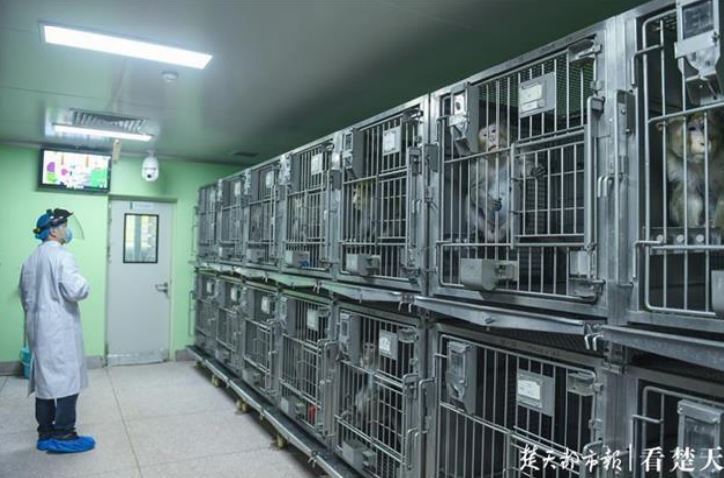WITH crumbling sewers and filthy animal cages, these are the shoddy conditions of labs in Wuhan which could have unleashed Covid.
A bombshell study found grotty sewage systems were potentially contaminating canals with toxic waste from the labs, university students failed to wear lab coats or eye protection, and facilities were slammed as “chaotic and crowded”.

The Wuhan Institute of Virology (WIV) has been at the centre of a storm ever since Covid first emerged just a stone’s throw from the facility which was known to be studying very similar bat viruses.
Shocking biosecurity lapses spanning over 40 years have also led to some to question the official Chinese line that the disease was passed from animals to humans.
And now a detailed examination of a host of other labs in Wuhan which carry out coronavirus research on bats has revealed a catalogue of shocking errors.

What the DRASTIC investigation found:
- Labs at Wuhan University were filled with “lots of debris”
- Students did not wear lab coats or eye protection
- There were no chemical waste facilities
- The “experiment” areas were not separated from the common areas
- Inspectors described the university lab as “crowded and chaotic”
- Sewage and drainage systems were damaged and old at the Wuhan Institute of Biological Products
- Documents show how waste was “potentially contaminating local canals and creeks”
- The animal experimentation centre at the Wuhan Institute of Virology contains 3,268 cages of live animals, including 12 ferret cages and 12 bat cages
Researchers have uncovered a number of unnerving biosafety hazards at the WIV, the Wuhan Institute of Biological Products, the Wuhan Centre for Disease Control and Prevention, and Wuhan University.
And they say suspicion does need to be just on WIV – but potentially all the labs in Wuhan need to come under scrutiny in the hunt for Covid’s origins.
Billy Bostickson, an anonymous researcher from DRASTIC, an international team of scientists and sleuths attempting to fill in the gaps on Covid’s origins, and Yvette Ghannam, from Walden University, compiled a damning 60-page report on the labs.
In 2019, just months before the deadly virus started spreading across the world, an inspection of the labs at Wuhan University revealed how the rooms were filled with “lots of debris”, there were no safety facilities, and students did not wear lab coats.
The concerning report, uncovered and quoted by the researchers, said there were no chemical waste facilities, and the “experiment” areas were not separated from the common areas, leading to potential contamination.
It left the labs in a “crowded and chaotic” state, inspectors said.
Bostickson and Ghannam confirmed the errors “support the possibility of a lab leak” of Covid, “either via an experimental animal or an infected researcher at one of the Wuhan University laboratories”.
And the authors noted another disturbing finding at the nearby Wuhan Institute of Biological Products.

During their investigation into the facility, they found its sewage and drainage systems were damaged and old, “potentially contaminating local canals and creeks”.
A tender from China Testing Network in 2019 said: “Some of the equipment and facilities are old, and the instrumentation and control functions in the station have been damaged, which has greatly affected the normal operation.”
Researchers also revealed the whopping size of the animal experimentation centre at the WIV, where suspicions have grown over the origins of the pandemic.
Built in 1996, the 1,216 m2 facility contains 3,268 cages of live animals, including 12 ferret cages and 12 bat cages.



It also holds 126 cages of Japanese white rabbits and 340 cages for rats.
The lab captures bats from the wild to be used as experimental animals, the researchers said – with video this week appearing to be the first to show the live creatures at WIV.
‘ACCIDENTAL LEAK’
“At least three laboratories were actively involved in studies of bat coronaviruses and/or bat sampling activities without the use of proper PPE in the years leading up to the Covid-19 pandemic,” Bostickson and Ghannam said.
“These three laboratories are thus considered potential sources for accidental leaks whether within the laboratory or during field sampling expeditions.”
What was initially dismissed as a conspiracy theory has gained traction to the extent that President Joe Biden has ordered US spies to investigate.
British intelligence has also reportedly assessed the lab leak theory and upgraded its likeliness from “remote” to “feasible”.
Speaking to The Sun Online, Bostickson said the study provides more circumstantial evidence of a lab leak, but “nothing concrete”.
“We need more whistleblowers, more internal documents, we need [Peter] Daszak and others to be subpoenaed and questioned,” he said.
Daszak is the head of EcoHealth Alliance, a New York-based non-profit organisation, which used grants from the National Institutes of Health in the US to fund controversial gain-of-function research in Wuhan.




Asked whether a lab leak could have been accidental or intentional, Bostickson said:” I don’t think [it was] deliberate but you never know.”
Gilles Demaneuf, a data analyst from DRASTIC, told The Sun Online the WIV is a “good contender” for the source of the lab leak – but it could have emerged from one of a number of labs in Wuhan.
“DRASTIC never only focused on WIV… we started by reviewing all labs involved in bat coronavirus research, including the Wuhan Institute of Biological Products next door,” he said.
Richard H Ebright, professor of chemistry and chemical biology at Rutgers University, also said staff working on projects around bat SARS-related coronaviruses at the WIV were poorly protected and there was a lax approach to biosecurity.
He said they used “personal protective equipment, usually just gloves; sometimes not even gloves” and safety standards “were usually just Biosafety level 2”.
What do we know about the Wuhan Institute of Virology?

THE Wuhan Institute of Virology is the highest security lab of its kind in all of China – and can be found right at the heart of the origins of the pandemic.
Various theories have been reported about the lab, which is headed up by scientist Dr Shi Zhengli, known as “Bat Woman”.
The lab specialises in bat-borne viruses and had been carrying out experiences on them since 2015.
Airlocks, full body suits, and chemical showers are required before entering and leaving the facility – the first in China to be accredited with biosafety level 4 (BSL-4).
BSL-4 labs are the only areas in the world where scientists are permitted to study diseases that have no cure.
Scientists from the lab even tested a mysterious virus which killed three miners 1,000 miles away in Yunnan province back in 2012.
It has been suggested this fatal bug may have been the true origin of Covid-19.
Experts at the lab also engineered a new type of hybrid ‘super-virus’ that can infect humans in 2015, according to journal Nature Medicine
The study was designed to show the risk of viruses carried by bats which could be transmitted to humans.
There is no suggestion the facility’s 2015 work is linked to the pandemic and the facility denies the lab leak claims.
The lab was also recruiting new scientists to probe coronaviruses in bats just seven days before the outbreak.
Professor Ebright said “that would pose a high risk of infection of field-collection, field-survey, or laboratory staff upon contact with a virus having the transmission properties of SARS-CoV-2”.
He is one of the growing number of scientists who have said the lab leak theory needs to be fully examined, telling The Sun Online he has an open mind about whether Covid could have been transmitted to humans via animals.
He said there is “circumstantial evidence” which is “noteworthy”.
‘SEEKING TO HIDE CULPABILITY’
Professor Ebright said that the Wuhan Institute of Virology “has the world’s largest collection of horseshoe-bat viruses, and that possessed and worked with the world’s closest published relative of” Covid.
And he said the behaviour of the Chinese has also raised suspicion, in particular refusal to allow World Health Organisation investigators full access.
“A nation or an institution seeking to its clear name immediately would open the books, open the databases, and open the freezers,” he said.
“A nation or an institution seeking to hide culpability would not.
“The actions of China and the Wuhan Institute of Virology over the last eighteen months have matched the actions of a nation and institution seeking to hide culpability.”
But China’s top diplomat, Yang Jiechi, has expressed serious concern to US Secretary of State Antony Blinken over the “absurd story” about the coronavirus escaping from a Wuhan laboratory.
Yang said Beijing firmly opposed what he called “abominable actions” over the pandemic which he said were being used to slander China, CCTV said.
“We urge the United States to respect facts and science, refrain from politicising the issue…and focus on international cooperation in the fight against the pandemic,” Yang said.
EU leaders have called for an unfettered investigation into the origins of the Covid pandemic.
“Investigators need complete access to whatever is necessary to really find the source of this pandemic,” European Commission President Ursula von der Leyen told a news conference in Brussels.
The head of the European Council, Charles Michel, added: “The world has the right to know exactly what happened in order to be able to learn the lessons.”
spyit





